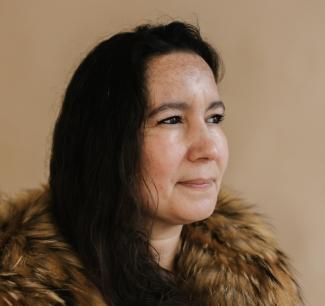
Cultural Survival’s new Bazaar Events Manager, Candyce Testa (Pequot), has a passion for life, which she credits to her upbringing. “My parents were proud of their hardworking nature, often showing off their calloused hands. They purchased 40 acres of land with 4 other families in Deblois, Maine, population 68. This town had a fish hatchery, a peat factory, and a blueberry factory; everything else was forests and blueberry fields,” Testa says.
When Testa and her family first moved to “The Land,” as they affectionately refer to their home, they settled in a tent, bathed in local ponds, learned how to use chalk lines on wood, and hammered nails all summer. Together, little by little, they built their house. With gas lights, a wood stove, and a hand pump in the sink—and without running water or electricity—Testa had plenty of time to explore the woods and immerse herself in books. As a child, Testa grew up with stories from her father about his Narragansett heritage, for example, being related to Tarzan Brown, a Narragansett man who ran the Boston Marathon barefoot and would conduct feats of strength. Only later did she and her family discover their Pequot ancestry. ”Being enrolled into the Pequot community was one of the best days of our lives,” Testa says.
Testa’s parents were creative and artistic, and she credits them for guiding her to a path in the arts. “My Pequot and Narragansett ancestors created beautifully ornate clothing and accessories. I draw upon this knowledge when creating with steel scissors, needles, glass beads, and fabricated sinew. My love of beading developed while working for the Mashantucket Pequot Museum and Research Center (Kutaputush—Thank you, Toni Weeden) and was further developed at the Tomaquag Museum (Kutaputush, Lorén Spears),” she says.

Candyce Testa’s beadwork and paintings.
Before starting as Cultural Survival Bazaar Events manager, Testa worked for the Mashantucket Pequot Tribal Nation in a cultural capacity, first working with archaeologists in the field, and then as an educator for many years at the museum. Later, in “a dream come true,” she was transferred to her community’s Cultural Resources Department. “In this position I did a little bit of everything, teaching the Blanket Dance, sharing the Pequot language, telling Indigenous stories from the region, teaching workshops, and working as tabulator at powwows,” Testa says, adding, “The pandemic made me come to the realization that I was spread too thin and needed to focus my energy.” Guided by this thought and with the support of her community, she wrote and received two federal language grants: one for the hire of two new language instructors and one for the creation of new language materials.
On her decision to join Cultural Survival, Testa says, “I wanted to be a part of a team that is creating a world where the voices of Indigenous Peoples are heard and respected, a team that realizes that the people who are living the most intricately woven existence with the Earth are the same people who should be making decisions about it. A team that values the voices and contributions of Indigenous women.” She names many Indigenous women as sources of inspiration, like Crystal Whipple (Pequot), Loren Spears (Narragansett), Clarissa Sabattis (Maliseet), Melissa Tantaquidgeon Zobel (Mohegan), Julia Marden (Aquinnah Wampanoag), Kerri Helme (Mashpee Wampanoag), Deborah Moorehead (Seaconke Pokanoket Wampanoag), Darlene Kascak (Schaghticoke), Junise Smith-Bliss (Pequot), Brittney Wally (Nipmuck), and the spirit of the late Trudie Lamb Richmond (Schgaticoke). “These are the Indigenous Culture Keepers in our area dedicating themselves to ensuring that the history and culture of the Northeast Woodlands Peoples are alive and thriving for future generations,” she says.
Testa’s new dream is to organize a Bazaar that reflects the diverse Indigenous Peoples around the world and to create a space that provides Indigenous Peoples with a platform to sell their creations to an American market while showcasing the Cultural Survival’s work and the effect our programs have on Indigenous lives. “Cultural Survival is an organization of people from across the globe who not only dream of making the world a better place, they also put in the elbow grease towards making it a reality.”
